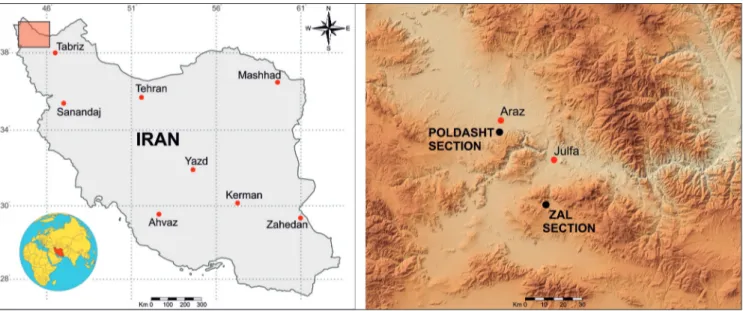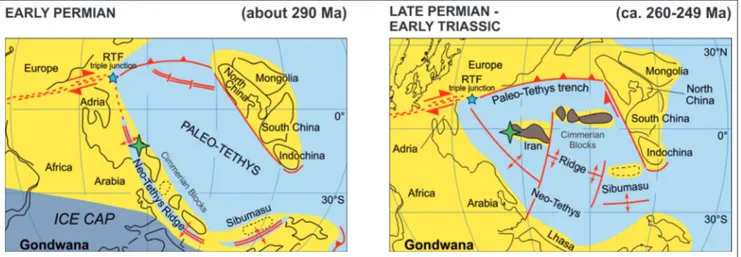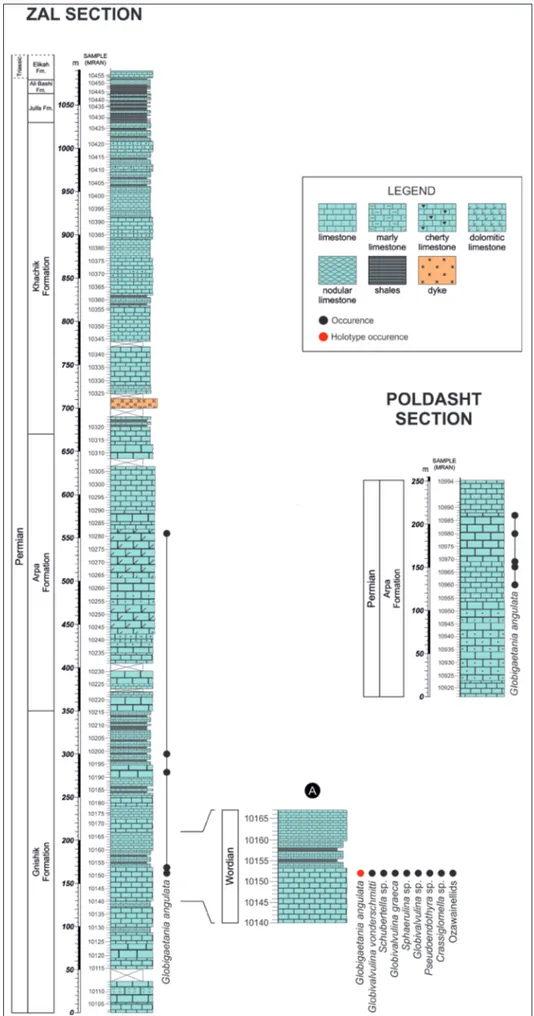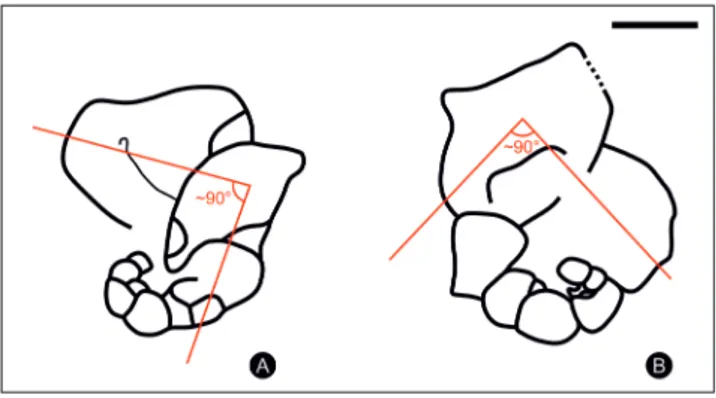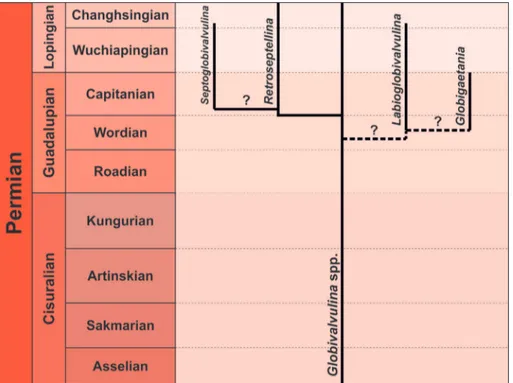GLOBIGAETANIA ANGULATA GEN. N. SP. N. (GLOBIVALVULININAE,
FORAMINIFERA) FROM THE WORDIAN (MIDDLE PERMIAN) OF NW IRAN
VALERIO GENNARI* & ROBERTO RETTORI
*Corresponding author. University of Perugia, Department of Physics and Geology, Via Pascoli, 06123 Perugia, Italy. E-mail: [email protected]
To cite this article: Gennari V. & Rettori R. (2019) - Globigaetania angulata gen. n. sp. n. (Globivalvulininae, Foraminifera) from the Wordian
(Middle Permian) of NW Iran. Riv. It. Paleontol. Strat., 125(1): 1-11.
Abstract. A new small biseriamminoid foraminifer, Globigaetania angulata gen. n. sp. n., is here described from
the Wordian of a Permian–Triassic sedimentary succession of NW Iran (Zal and Poldasht stratigraphic sections). The new taxon, dedicated to Prof. Maurizio Gaetani, is characterised by peculiar morphology, coiling, and structures that are characteristic of the subfamily Globivalvulininae Reitlinger, 1950, family Globivalvulinidae Reitlinger, 1950, superfamily Biseriamminoidea Chernysheva, 1941. The introduction of the new taxon contributes to the knowledge of the systematics and evolution of the Palaeozoic biserial microgranular foraminifera.
Received: June 29, 2018; accepted: October 25, 2018
Keywords: Systematics; New taxon; Small foraminifera; Globivalvulinidae; Biseriamminoids; Palaeozoic.
I
ntroductIonAlthough the Permian Period was character-ised by two major biological crises (end-Guadalupi-an (end-Guadalupi-and end-Permi(end-Guadalupi-an) (Jin et al. 1994; Erwin 2006; Clapham et al. 2009; Shen & Bowring 2014), it was also an important phase of marine biotic diversifi-cation (Vachard et al. 2010; Campi 2012; Payne & Clapham 2012). In particular, a high increase in the number of genera and species of foraminifers was recorded in several sedimentary successions all over the world [e.g., Iran, Pamir, Turkey, South China, and USA (Nestell & Nestell 2006; Gaillot & Vachard 2007; Filimonova 2010; Groves & Wang 2013)]. From the Kungurian, the family Globivalvulini-dae Reitlinger, 1950 showed a very rapid radiation, mostly at the generic level (Altıner 1997; Vachard et al. 2006; Vachard 2016), reaching a maximum during the Capitanian–Wuchiapingian time interval. On the basis of this evolutionary radiation, coupled with the development of a relative complexity of morphological features, Gaillot & Vachard (2007) subdivided the family Globivalvulinidae in four
subfamilies (Globivalvulininae Reitlinger, 1950; Paraglobivalvulininae Gaillot & Vachard, 2007; Dagmaritinae Bozorgnia, 1973 and Paradagmariti-nae Gaillot & Vachard, 2007). This family due to its richness and abundance in shallow-water carbonate environments became a useful biostratigraphic tool for regional correlations in the Middle–Late Permi-an, together with other groups such as the Pseu-dovidalinidae Altıner, 1988 and the Hemigordiopsi-dae Nikitina, 1969 (Hance et al. 2011; Vachard 2016; Vachard et al. 2017; Gennari et al. 2018). The sub-family Globivalvulininae is the first to appear in the stratigraphic record and is characterised by forms having a biserial test, mainly semi-evolute, planispir-ally to slightly trochospirplanispir-ally or trochospirplanispir-ally coiled (Hance et al. 2011; Gennari et al. 2018). Vachard & Montenat (1981) and Vachard et al. (2006) high-lighted the ecology of the globivalvulinins stating that these taxa can occupy confined environments and be tolerant to hypersalinity. Consequently, this adaptation to highly stressed conditions, may have allowed the globivalvulinins to survive the PTB ex-tinction (Vachard et al. 2006; Song et al. 2016).
In this work, Globigaetania angulata gen. n.
sedimen-tary succession of NW Iran is described, high-lighting the distinctive morphological characters wich allowed to include it within the subfamily Globivalvulininae.
G
eoloGIcalS
ettInGNW Iran, where the studied sections are lo-cated (Fig. 1), is considered as part of the Central Iran domain. It represents one of the several struc-tural units that defined the complex tectonic assem-blage of Iran (Stöcklin 1968; Alavi 1991; Gaetani et al. 2009; Zanchi et al. 2009). During the Permian, the tectonic evolution of NW Iran was controlled by the opening of the Neotethys Ocean that took place along the northern margin of Gondwana. In particular, NW Iran belonged to the Cimmerian terranes which drifted northward, from southern gondwanan tropical palaeolatitudes (Early Permian), attaining equatorial palaeolatitudes by the Middle– Late Permian (Fig. 2) (Sengör 1979; Stampfli & Borel 2002; Angiolini et al. 2003; Gaetani et al. 2009; Muttoni et al. 2009; Berra & Angiolini 2014).
The analysed Zal and Poldasht stratigraphic sections are located respectively, 26.5 km SSW of Julfa city and 6 km SSW of Araz village (NW Iran) (Fig. 1). In the study area, the Middle Permian– Lower Triassic succession consists of about 1100 m of well exposed carbonate rocks. A historical re-view of the lithostratigraphic subdivisions of the
above cited sedimentary succession was provided by Ghaderi et al. (2016), who divided it into the Gnishik, Khachik, Julfa, Ali Bashi, and Elikah formations in ascending order. This subdivision is herein adopted. However, although this previous work did not take into account the Arpa Formation, we recognised the distinctive lithological characteristics (light grey mas-sive bioclastic limestones and nodular chert in the lower part), that define it (Leven 1975). The Arpa Formation has been established in Transcaucasia and stratigraphically positioned between the under-lying Gnishik Formation and the overunder-lying Khachik Formation (Leven 1975). We investigated the Zal section from bottom to top and studied the Gnishik (350 m), Arpa (320 m), Khachik (360 m), Julfa (33 m), Ali Bashi (16 m), and Elikah (10.5 m) formations whereas the Poldasht section is characterised by the Arpa Formation (251 m) (Fig. 3).
The Gnishik Formation consists of dark-grey thin-bedded limestones and massive limestones al-ternating with marly limestones and black shales. The upper part of the formation shows an increase of marly limestones and black shales. The Arpa Formation is mostly represented by light grey thik-bedded and massive bioclastic limestones. Nodular chert is present in the lower part of the formation. The overlying Khachik Formation consists of thin- and thick-bedded limestones passing, upward, into marly limestones and limestones with chert nodules interbedded with shales. The topmost part of the Khachik Formation is characterised by dark grey
Fig. 1 - Geographic map showing the location of the Zal section (38° 43′ 9.1″ N and 45° 34′ 37.5″ E) and the Poldasht section (39° 3′ 49.3″ N and 45° 17′ 50.6″ E) (NW Iran).
limestones, forming a unit named the Codonofusiella
Limestone. The Julfa Formation (Julfa Beds sensu Stepanov et al. 1969) is composed of nodular lime-stones and marly limelime-stones with intercalations of grey to red shales. The Ali Bashi Formation (Teichert et al. 1973) comprises the unnamed shaly unit (Ghaderi et al. 2014), mostly characterised by red shales and the Paratirolites Limestone
rep-resented by red, nodular, marly limestones rich in ammonoids. The Ali Bashi Formation is succes-sively overlain by the Elikah Formation composed, in the studied part, of red, grey shale (“Boundary Clay”) and yellow-grey, marly, thin-bedded lime-stones.
MaterIaland Methods
In this study, we analysed a total of 432 limestone samples. Three hundred fifty-four samples were collected from the Zal sec-tion (Gnishik, Arpa, Khachik, Julfa, Ali Bashi, and Elikah Forma-tions) and seventy-eight from the Arpa Formation in the Poldasht section (Fig. 3). All samples have been processed by the National Iranian Oil Company (providing two thin sections per sample) and they have been labelled with a progressive code number preceded by the prefix MRAN. Most samples contain a diversified forami-niferal assemblage and Globigaetania angulata gen. n. sp. n. was
re-corded in five samples from the Zal section (Gnishik Formation and Arpa Formation) and five samples from the Poldasht section (Arpa Formation). Images of the specimens were performed, at different magnifications, using Leica DM4500 P LED microscope equipped with a Leica MC170 HD digital camera. The specimens were measured using the open-source software ImageJ (https:// imagej.nih.gov/ij/) whereas the illustrative drawings were prepared using the vector graphics editor CorelDraws X7. The studied ma-terial is housed at the palaeontological laboratories of the NIOC (National Iranian Oil Company building, Hafez crossing, Taleghani Avenue, Tehran, Iran) under the numbers MRAN 10103 to MRAN 10456 (Zal) and MRAN 10917 to MRAN 10994 (Poldasht).
S
ySteMatIcP
alaeontoloGyPhylum FORAMINIFERA d’Orbigny, 1826
Class FuSulInata Gaillot & Vachard, 2007
Subclass FuSulInana Maslakova, 1990
nom. correct. Vachard et al., 2010 Order Endothyrida Fursenko, 1958
Superfamily Biseriamminoidea Chernysheva, 1941 emend. Gennari et al., 2018
Family Globivalvulinidae Reitlinger, 1950 emend. Gennari et al., 2018
Subfamily Globivalvulininae Reitlinger, 1950 emend. Gennari et al., 2018
Type genus: Globivalvulina Schubert, 1921
Globigaetania gen. n.
Type species: Globigaetania angulata gen. n. sp. n.
Derivation of the name: In honour of Maurizio Gaetani
(Dipartimento di Scienze della Terra “A. Desio”, Milano, Italy), eminent expert of the geology and palaeontology of Iran.
Diagnosis: Globivalvulinin foraminifer characterised by the
presence of dense supplementary nodular structures and angular chambers at the adult stage. The wall is calcareous, microgranular, single layered and the aperture is interiomarginal, protected by a val-vular projection.
Description. Test free, globular proloculus fol-lowed by a biserial, oscillating to planispirally coiled in the juvenile stage and planispiral final stage. In the first stage, the chambers are globular, small in size with a low growth rate. This part is character-ised by a low spira with the successive whorls not in contact with the previous one like the beginning of a “cornucopia” (as observed in equatorial or oblique equatorial sections; Pl. 1, figs 1-2; Pl. 2, figs
Fig. 2 - Palaeogeographic evolution of the Cimmerian terranes including NW Iran. The position of the study area is indicated by a green star. Modified from Berra & Angiolini (2014).
Fig. 3 - Stratigraphic logs of the sec-tions studied in this work, with the stratigraphic occu-rences of Globigaetania angu-lata gen. n. sp. n.
A) Detail of the type level of the new taxon with the accompanying foraminiferal assemblage.
4-5). In the second stage, chambers are subglobular to angular, trapezoidal in section, suddenly increas-ing in size with a high growth rate. This ontogenetic passage from globular to subglobular-angular shape of the chambers is due to the tendency to flatten-ing of the peripheral outline as in Charliella Altıner
& Özkan-Altıner, 2001. During the growth of the adult stage, the alignment axes change in direction, forming an angle of about 90 degrees (Pl. 1, figs 1-2; Pl. 2, figs 4-5; Fig. 4). Furthermore, the last large chamber may protrude towards the juvenile stage, covering it partially. The second stage is also marked by the presence of dense deposits of the septa in-side the chamber forming supplementary nodular structures (Pl. 1, figs 1, 8; Pl. 2, figs 2-3; Fig. 5) like in Labioglobivalvulina Gaillot & Vachard, 2007. The
test wall is calcareous, microgranular, single layered. Aperture interiomarginal and protected by a valvular projection (Pl. 1, fig. 1; Pl. 2, fig. 5; Fig. 4).
Remarks. Globigaetania gen. n. differs from
Globivalvulina by the presence of
supplemen-tary nodular structures, subglobular to angular chambers, and flattened peripheral outline in the second stage of coiling (Fig. 5). It differs from
Labioglobivalvulina in its higher growth rate during
the subglobular to angular chambers adult stage of coiling. Globigaetania gen. n. differs from Charliella by
having supplementary nodular structures and by the absence of a thickening at the anterior side of the septa and a four-layered wall. Globigaetania gen. n.
differs from Retroseptellina Gaillot & Vachard, 2007
by having supplementary nodular structures, sub-globular to angular chambers, and different shape of the septa, which are strongly backward curvat-ed in Retroseptellina. The new genus differs from all
representatives of the Globivalvulininae because of the abrupt change of the alignment axes of the last two chambers.
Considering the phylogenetic reconstruc-tion proposed by Altıner & Özkan-Altıner (2001; fig. 2), based on wall structure and composition,
Globigaetania gen. n. seems to branch from the
lineage Globivalvulina spp.-Retroseptellina decrouezae
(=Globivalvulina decrouezae Köylüoglu & Altıner,
1989)-Septoglobivalvulina Lin, 1978. In this study, we
consider two separate evolutionary trends (Fig. 6). In the first lineage, around the Wordian-Capitanian boundary, the genus Retroseptellina
di-rectly evolved from Globivalvulina spp. developing
strongly backward curvated septa (Altıner & Özkan-Altıner 2001); and leading later to Septoglobivalvulina.
Herein, the evolutionary relationship between this latter genus and Retroseptellina is retained doubtful
because Septoglobivalvulina was considered the
proba-ble ancestor of the subfamily Paraglobivalvulininae by Vachard et al. (2006) and Gaillot & Vachard (2007) and accordingly not belonging to the sub-family Globivalvulininae.
The second evolutionary lineage, during the Wordian, starting from Globivalvulina spp. led to
the genera Labioglobivalvulina (Kolodka et al. 2012)
and Globigaetania gen. n., both characterised by
sup-plementary internal nodular structures. Because of the lack of detailed chronostratigraphic data about the first appearance of these two genera, at the moment it is difficult to define the ancestor-de-scendant relationship between them. However, we hypothesise the derivation of Globigaetania gen. n.
from Labioglobivalvulina because the new taxon would
Fig. 4 - Cartoon showing the change of direction of the alignment axes, during the growth of the adult stage of Globigaeta-nia angulata gen. n. sp. n. A: oblique equatorial section; B:
oblique equatorial section (see Pl. 2, fig. 5 and Pl. 2, fig. 4 for the original specimens). Scale bar: 200 µm.
Fig. 5 - Drawing of the distinctive supplementary nodular structures and angular chambers of the new taxon. A: holotype, slight-ly oblique equatorial section; B: tangential section (see Pl. 1, fig. 1 and Pl. 2, fig. 2 for the original specimens). Scale bar 200 µm.
evolve via acquisition of two new features, change of direction of the alignment axes and angular chambers, in the adult stage.
Stratigraphic and geographic distribution. Middle Permian (=Guadalupian), Wordian to Capitanian, Iran and central Japan.
Globigaetania angulata gen. n. sp. n. Pl. 1, figs 1-8; Pl. 2, figs 1-8; Figs 4, 5 1983 Globivalvulina sp. - Jenny-Deshusses C., pl. 6, fig. 7.
2012 Urushtenella sp. - Kobayashi F., p. 327, pl. 2, figs. 7, 10.
Derivation of the name: After the angular shape of the last
chambers.
Holotype: The specimen in slightly oblique equatorial
tion illustrated in Plate 1, fig. 1, from sample MRAN 10151; Zal sec-tion. The type material is housed at the National Iranian Oil Com-pany, Department of Palaeontology, Geochemistry and Researches (Tehran, Iran).
Type level: Middle Permian (=Guadalupian), Wordian, 162
m above the base of the Gnishik Formation in the Zal section (Fig. 3).
Type locality: Zal, NW Iran. Coordinates: 38° 43′ 9.1″ N and
45° 34′ 37.5″ E.
Assemblage: In the type material the new species Globigae-tania angulata gen. n. sp. n. is associated with Globivalvulina sp., Globi-valvulina vonderschmitti Reichel, 1946, GlobiGlobi-valvulina graeca Reichel, 1946, Sphaerulina sp., Schubertella sp., Pseudoendothyra sp., Crassiglomella sp.,
Ozawainellids, Pseudovermiporella sp., crinoids, bivalves, and ostracodes. Diagnosis: Type species of the genus Globigaetania gen. n.
with a high number of pairs of chambers. The second part of the test is the most diagnostic, being characterised by three to four pairs of subglobular to angular chambers rapidly increasing in size.
Description. The free test of Globigaetania
angula-ta gen. n. sp. n. is toangula-tally biserial with eight to ten
pairs of chambers. The first part of the test, slightly trochospirally to planispirally coiled in 1 ½ whorls, is composed of a spherical proloculus followed by
Fig. 6 - Evolutionary relationships showing the position of
Globigaetania gen. n. Dashed
lines represent the uncer-tainty in the first appearanc-es; question marks indicate the uncertain evolutionary relationships. See text for details.
Plate 1
Globigaetania angulata gen. n. sp. n.
1) holotype, slightly oblique equatorial section, sample MRAN 10151; red arrows indicate the supplementary nodular structures whereas the yellow one points to the valvular projection; 2) oblique equatorial section, sample MRAN 10151; 3) oblique section, sample MRAN 10199; 4) oblique section, sample MRAN 10192; 5) oblique equatorial section, sample MRAN 10199; 6) oblique section, sample MRAN 10192; 7) oblique tangential section, sample MRAN 10151; arrow indicates the microgranular, single layered wall; 8) tangential section, sample MRAN 10281; red arrow points to the supplementary nodular structure whereas the yellow one indicates the micro-granular, single layered wall. Scale bar: 200 µm.
Plate 2
Globigaetania angulata gen. n. sp. n.
1) oblique section, sample MRAN 10199; 2) tangential section, sample MRAN 10199; arrow indicates the supplementary nodular structure; 3) oblique section, sample MRAN 10960; arrow points to the supplementary nodular structure; 4) oblique equatorial section, sample MRAN 10969; 5) oblique equato-rial section, sample MRAN 10969; arrow indicates the valvu-lar projection; 6) oblique equatorial section, sample MRAN 10980; 7) oblique section, sample MRAN 10980; 8) oblique axial section, sample MRAN 10987. Scale bar: 200 µm.
five to six pairs of globular chambers slowly in-creasing in size. The second part of the test, totally planispirally coiled, is made by three to four pairs of chambers subglobular to angular in shape rapidly increasing in size. The first chamber of the adult stage marks both the increasing of the size of the successive chambers (Pl. 1, figs 1-2; Pl. 2, figs 3-6) and the first appereance of the supplementary nod-ular structures (Pl. 1, fig. 1; Pl. 2, fig. 3; Fig. 5). The test wall is calcareous, microgranular, single layered. Aperture interiomarginal and protected by a valvu-lar projection.
Dimensions (µm). Height of the test: 570-910. Width of the test: 500-600. Number of pairs of chambers: up to 8-10. Thickness of the wall: 15-20. Remarks. The oblique and tangential axial sections of Globivalvulina vonderschmitti Reichel, 1946 are
sim-ilar to those of Globigaetania angulata gen. n. sp. n.
However, the morphological differences between the two species are more evident in equatorial or oblique equatorial sections in which the diagnos-tic features of each species can be detectable. The specimens illustrated by Kobayashi (2012) in pl. 2, figs 7, 10 and assigned to Urushtenella sp., could
be-long to Globigaetania gen. n. due to the presence of
supplementary nodular structures and to the char-acteristics of the second stage of coiling. These features are not clearly observable in the specimens figured as Urushtenella sp. by Kobayashi (2012) in pl.
2, figs 11, 18. Furthermore, the three-layered wall of Urushtenella as originally described by
Pronina-Nestell (Pronina-Pronina-Nestell & Pronina-Nestell 2001, p. 216) is not visible in the material illustrated by Kobayashi (2012).
Stratigraphic and geographic distribution. Middle Permian (=Guadalupian), Wordian to Capitanian, Iran and central Japan.
c
oncluSIonSAbundant and well preserved specimens having distinctive morphological features have been recognised and attributed to the new genus
Globigaetania – with type-species Globigaetania angu-lata gen. n. sp. n. This taxon occurs in the Wordian
part of the studied succession and it is character-ised by globivalvulinin coiling, wall, and aperture types, and by the presence of supplementary nod-ular structures and angnod-ular chambers at the adult
stage. Accordingly, Globigaetania angulata gen. n.
sp. n. has been included into the Globivavulininae (Globivalvulinidae, Biseriamminoidea), enlarging its taxonomic composition. From an evolutionary point of view, the new taxon is phylogenetically re-lated to the genus Labioglobivalvulina. The new genus
could be a potential palaeobiogeographic marker, due to its areal distribution, at the moment con-strained to Iran and Japan.
Acknowledgements: This study is part the project “Paleontology
and Biozonation of Paleozoic Sediments of Zagros and Central Iran Basins” (coordinators M. Ghorbani and R. Rettori) supported by the National Iranian Oil Company (NIOC), Tehran. Many thanks are due to Marco Cherin for his useful suggestions. We thank three anony-mous reviewers for their thoughtful reviews that greatly improved the manuscript.
RefeRences
Alavi M. (1991) - Tectonic Map of the Middle East. Geologi-cal Survey of Iran, Tehran, 60 pp.
Altıner D. (1988) - Pseudovidalinidae n. fam. and Angelina n.
gen. from the Upper Permian of south and southeast Turkey. Rev. Paléobiol., Benthos’86, 2: 25-36.
Altıner D. (1997) - Origin, morphologic variation and evolu-tion of dagmaritin-type biseriamminid stock in the Late Permian. In: Ross C.A., Ross J.R.P. & Brenckle P.L. (Eds) - Late Paleozoic Foraminifera; their biostratigraphy, evo-lution and paleoecology; and the Mid-Carboniferous Boundary 36: 1-4. Cushman Foundation for Foramini-feral Research, Special Publication, Washington.
Altıner D. & Özkan-Altıner S. (2001) - Charliella rossae n. gen.,
n. sp. from the Tethyan Realm: remarks on the evolu-tion of Late Permian biseriamminids. J. Foramin. Res., 31:
309-314.
Angiolini L., Balini M., Garzanti E., Nicora A. & Tintori A. (2003) - Gondwanan deglaciation and opening of Neo-tethys: Palaeontological and sedimentological evidence from interior Oman. Palaeogeogr., Palaeoclimatol., Palaeoecol.,
196: 99-123.
Berra F. & Angiolini L. (2014) - The evolution of the Tethys region throughout the Phanerozoic: A brief tectonic re-construction. In: Marlow L., Kendall C. & Yose L. (Eds) - Petroleum systems of the Tethyan region 106: 1-27. AAPG Memoir.
Bozorgnia F. (1973) - Paleozoic foraminiferal biostratigraphy of central and east Alborz Mountains, Iran. National Iranian Oil Company, Geological Laboratories, Publica-tion, 4: 1-185.
Campi M.J. (2012) - The Permian - A Time of Major Evolu-tions and RevoluEvolu-tions in the History of Life. In: Talent J.A. (Ed.) - Earth and Life: 705-718. International Year of Planet Earth, Science+Business Media B.V., Dordre-cht, Netherlands.
otlozhenii Urala. Doklady Akademiya Nauk SSSR, 31: 69-70.
Clapham M.E., Shen S.Z. & Bottjer D.J. (2009) - The double mass extinction revisited: reassessing the severity, selec-tivity, and causes of the end-Guadalupian biotic crisis (Late Permian). Palaeobiology, 35: 32-50.
d’Orbigny A. (1826) - Tableau méthodique de la classe des Céphalopodes. Ann. Sci. Nat., 7(2): 245-314.
Erwin D.H. (2006) - Extinction. How Life on Earth Near-ly Ended 250 Million Years Ago. Princeton University Press, Princeton, Oxford, 296 pp.
Filimonova T.V. (2010) - Smaller foraminifers of the Lower Permian from Western Tethys. Stratigr. Geol. Correl., 18:
687-811.
Fursenko A.V. (1958) - Osnovnye etapy razvitiya faun fora-minifer v geologicheskom proshlom. Trudy Instituta Geologicheskikh Nauk, Akademiya Nauk Belorusskoi SSR, 1: 10-29.
Gaetani M., Angiolini L., Ueno K., Nicora A., Stephenson M.H., Sciunnach D., Rettori R., Price G.D. & Sabouri J. (2009) - Pennsylvanian-Early Triassic stratigraphy in the Alborz Mountains (Iran). In: Brunet M.F., Wilmsen M. & Granath J.W. (Eds) - South Caspian to Central Iran Basins 312: 79-128. Geol. Soc. London, Spec. Pub. Gaillot J. & Vachard D. (2007) - The Khuff Formation
(Midd-le East) and time equiva(Midd-lents in Turkey and South China: biostratigraphy from Capitanian to Changhsingian times (Permian), new foraminiferal taxa, and palaeogeographi-cal implications. Coloquios de Paleontología, 57: 37-223.
Gennari V., Cherin M. & Rettori R. (2018) - Systematic re-vision and phylogenetic assessment of the subfami-lies included in the foraminiferal family Globivalvuli-nidae. Acta Palaeontol. Pol., https://doi.org/10.4202/
app.00511.2018.
Ghaderi A., Garbelli C., Angiolini L., Ashouri A.R., Korn D. & Rettori R. (2014) - Faunal changes near the end Permian extinction: the brachiopods of the Ali Bashi Mountains, NW Iran. Riv. It. Paleontol. Strat., 120: 27-59.
Ghaderi A., Khalil Abad M.T.K., Ashouri A.R. & Korn D. (2016) - Permian Calcareous algae from the Khachik Formation at the Ali Bashi Mountains, NW of Iran.
Arab. J. Geosci., 9: 699.
Groves J.R. & Wang Y. (2013) - Timing and size selectivity of the Guadalupian (Middle Permian) fusulinoidean extin-ction. J. Paleontol., 87(2): 183-196.
Hance L., Hou H. & Vachard D. (with the collaboration of Devuyst F. X., Kalvoda J., Poty E. & Wu X.) (2011) - Upper Famennian to Visean foraminifers and some car-bonate microproblematica from South China-Hunan, Guangxi and Guizhou. Geological Publishing House, Beijing, 359 pp.
Jenny-Deshusses C. (1983) - Le Permien de l’Elbourz Cent-ral et Oriental (Iran): stratigraphie et micropaléontolo-gie (Foraminifères et Algues). PhD thesis, Université de Genève, 214 pp.
Jin Y.G., Zhang J. & Shang Q.H. (1994) - Two phases of the end-Permian mass extinction. In: Embry A.F., Beauchamp B. & Glass D.J. (Eds) - Pangea: global
en-vironments and resources. Memoir 17: 813-821. Canadi-an Society of Petroleum Geologists, Calgary.
Kobayashi F. (2012) - Permian non-fusuline foraminifers of the Akasaka Limestone (Japan). Rev. Paléobiol., 31:
313-335.
Kolodka C., Vennin E., Vachard D., Trocmé V. & Goodarzi M. (2012) - Timing and progression of the end-Guadalupi-an crisis in the Fars province (Dalend-Guadalupi-an Formation, Kuh-e Gakhum, Iran) constrained by foraminifers and other carbonate microfossils. Facies, 58: 131-153.
Köylüoglu M. & Altıner D. (1989) - Micropaléontologie (fora-minifères) et biostratigraphie du Permien supérieur de la région d’Hakkari (SE Turquie). Rev. Paléobiol., 8: 467-503.
Lin J.X. (1978) - Carboniferous-Permian Foraminifera. In: Hubei Institute of Geology (Ed.) - Atlas of fossils of southcentral China: 10-43. Geological Publishing House, Beijing.
Leven E.Ja. (1975) - Permian stratigraphy of Transcaucasia.
Sov. Geol., 1: 96-110.
Maslakova N.I. (1990) - Kriterii vudeleniya vusshukh takso-nov foraminifer. In: Menner V.V. (Ed.) - Systematics and phylogeny of Invertebrata: the criteria for establishing higher taxa: 22-27. Nauka, Moscow.
Muttoni G., Gaetani M., Kent D.V., Sciunnach D., Angiolini L., Berra F., Garzanti E., Mattei M. & Zanchi A. (2009) - Opening of the Neo-Tethys Ocean and the Pangea B to Pangea A transformation during the Permian. GeoA-rabia, 14(4): 17-48.
Nestell G.P. & Nestell M.K. (2006) - Middle Permian (Late Guadalupian) foraminifers from Dark Canyon, Gua-dalupe Mountains, New Mexico. Micropaleontology, 52:
1-50.
Nikitina A.P. (1969) - Genus Hemigordiopsis (Foraminifera) from
the Late Permian of Primorie. Paleontol. Zh., 3: 63-69.
Payne J.L. & Clapham M.E. (2012) - End-Permian mass ex-tinction in the oceans: An ancient analog for the twen-ty-first century?. Annu. Rev. Earth Pl. Sc. Lett., 40: 89-111.
Pronina-Nestell G.P. & Nestell M.K. (2001) - Late Changhsin-gian foraminifers of the Northwestern Caucasus. Micro-paleontology, 47: 205-234.
Reichel M. (1946) - Sur quelques foraminifères nouveaux du Permien méditerranéen. Eclogae Geol. Helv., 38: 524-560.
Reitlinger E.A. (1950) - Foraminifery srednekamennougo-lnykh otlozhenii tsentralnoi chasti Russkoi platformy (isklyuchaya semeistvo Fusulinidae). Akademiya Nauk SSSR, Trudy Instituta Geoiogicheskikh Nauk, geologi-chevskaya seriya 47, 126 pp.
Schubert R.J. (1921) - Paläeontologische Daten zur Stammes-geschichte der Protozoen. Paläeontol. Z., 3: 129-188.
Sengör A.M.C. (1979) - Mid-Mesozoic closure of Permo-Trias-sic Tethys and its implications. Nature, 279: 590-593.
Shen S.Z. & Bowring S.A. (2014) - The end-Permian mass extinction: a still unexplained catastrophe. Natl. Sci. Rev.,
1: 492-495.
Song H., Tong J., Wignall P.B., Luo M., Tian L., Song H., Huang Y. & Chu D. (2016) - Early Triassic disaster and opportunistic foraminifers in South China. Geol. Mag.,
Stampfli G.M. & Borel G.D. (2002) - A plate tectonic model for the Paleozoic and Mesozoic constrained by dynamic plate boundaries and restored synthetic oceanic iso-chrons. Earth Planet. Sc. Lett., 196: 17-33.
Stepanov D.L., Golshani F. & Stöcklin J. (1969) - Upper Per-mian and PerPer-mian–Triassic Boundary in North Iran.
Geol. Surv. Iran. Rep., 12: 1-72.
Stöcklin J. (1968) - Structural history and tectonics of Iran; a review. AAPG Bull., 52: 1229-1258.
Teichert C., Kummel B. & Sweet W.C. (1973) - Permian-Trias-sic strata, Kuh-e-Ali Bashi, northwestern Iran. Bull. Mus. Comp. Zool., 145: 359-472.
Vachard D. (2016) - Permian smaller foraminifers; taxonomy, biostratigraphy and biogeography. Geological Society of London, Special Publications, London, 450 pp.
Vachard D. & Montenat C. (1981) - Biostratigraphie, micro-paléontologie et paléogéographie du Permien de la ré-gion de Tezak (Montagnes Centrales d’Afghanistan).
Palaeontographica B, 178: 1-88.
Vachard D., Gaillot J., Pille L. & Blazejowski B. (2006) - Prob-lems on Biseriamminoidea, Mississippian-Permian bise-rially coiled foraminifera. A reappraisal with proposals.
Rev. Esp. Micropaleontol., 38: 453-492.
Vachard D., Pille L. & Gaillot J. (2010) - Palaeozoic Foramini-fera: systematics, palaeoecology and responses to global changes. Rev. Micropaleontol., 53: 209-254.
Vachard D., Rettori R., Altıner D. & Gennari V. (2017) - The Permian foraminiferal family Pseudovidalinidae and the genus Altineria emend. herein. J. Foramin. Res., 47:
279-283.
Zanchi A., Zanchetta S., Berra F., Mattei M., Garzanti E., Molyneux S., Nawab A. & Sabouri J. (2009) - The Eo-Cimmerian (Late? Triassic) orogeny in north Iran. In: Brunet M.F., Wilmsen M. & Granath J.W. (Eds) - South Caspian to Central Iran Basins 312: 31-55. Geol. Soc. London, Spec. Pub.
